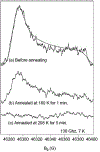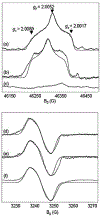EPR characterization of ascorbyl and sulfur dioxide anion radicals trapped during the reaction of bovine Cytochrome c Oxidase with molecular oxygen
- PMID: 20056464
- PMCID: PMC6446898
- DOI: 10.1016/j.jmr.2009.12.017
EPR characterization of ascorbyl and sulfur dioxide anion radicals trapped during the reaction of bovine Cytochrome c Oxidase with molecular oxygen
Abstract
The reaction intermediates of reduced bovine Cytochrome c Oxidase (CcO) were trapped following its reaction with oxygen at 50 micros-6 ms by innovative freeze-quenching methods and studied by EPR. When the enzyme was reduced with either ascorbate or dithionite, distinct radicals were generated; X-band (9 GHz) and D-band (130 GHz) CW-EPR measurements support the assignments of these radicals to ascorbyl and sulfur dioxide anion radical (SO2(-.)), respectively. The X-band spectra show a linewidth of 12 G for the ascorbyl radical and 11 G for the SO2(-.) radical and an isotropic g-value of 2.005 for both species. The D-band spectra reveal clear distinctions in the g-tensors and powder patterns of the two species. The ascorbyl radical spectrum displays approximate axial symmetry with g-values of g(x)=2.0068, g(y)=2.0066, and g(z)=2.0023. The SO2(-.) radical has rhombic symmetry with g-values of g(x)=2.0089, g(y)=2.0052, and g(z)=2.0017. When the contributions from the ascorbyl and SO2(-.) radicals were removed, no protein-based radical on CcO could be identified in the EPR spectra.
2009 Elsevier Inc. All rights reserved.
Figures








Similar articles
-
Radical formation in cytochrome c oxidase.Biochim Biophys Acta. 2011 Oct;1807(10):1295-304. doi: 10.1016/j.bbabio.2011.06.012. Epub 2011 Jun 22. Biochim Biophys Acta. 2011. PMID: 21718686 Free PMC article.
-
Reduction of the ascorbyl free radical to ascorbate by thioredoxin reductase.J Biol Chem. 1998 Sep 4;273(36):23039-45. doi: 10.1074/jbc.273.36.23039. J Biol Chem. 1998. PMID: 9722529
-
Spin trapping endogenous radicals in MC-1010 cells: evidence for hydroxyl radical and carbon-centered ascorbyl radical adducts.Mol Cell Biochem. 1995 Jul 19;148(2):155-64. doi: 10.1007/BF00928153. Mol Cell Biochem. 1995. PMID: 8594420
-
Electronic paramagnetic resonance (EPR) for the study of ascorbyl radical and lipid radicals in marine organisms.Comp Biochem Physiol A Mol Integr Physiol. 2013 Aug;165(4):439-47. doi: 10.1016/j.cbpa.2013.02.021. Epub 2013 Feb 26. Comp Biochem Physiol A Mol Integr Physiol. 2013. PMID: 23485428 Review.
-
Tryptophan or tyrosine? On the nature of the amino acid radical formed following hydrogen peroxide treatment of cytochrome c oxidase.Biochim Biophys Acta. 2004 Apr 12;1655(1-3):372-80. doi: 10.1016/j.bbabio.2003.06.006. Biochim Biophys Acta. 2004. PMID: 15100053 Review.
Cited by
-
A hot oxidant, 3-NO2Y122 radical, unmasks conformational gating in ribonucleotide reductase.J Am Chem Soc. 2010 Nov 3;132(43):15368-79. doi: 10.1021/ja1069344. J Am Chem Soc. 2010. PMID: 20929229 Free PMC article.
-
Differential effects of glutamate-286 mutations in the aa(3)-type cytochrome c oxidase from Rhodobacter sphaeroides and the cytochrome bo(3) ubiquinol oxidase from Escherichia coli.Biochim Biophys Acta. 2011 Oct;1807(10):1342-8. doi: 10.1016/j.bbabio.2011.06.001. Epub 2011 Jun 12. Biochim Biophys Acta. 2011. PMID: 21684251 Free PMC article.
-
Radical formation in cytochrome c oxidase.Biochim Biophys Acta. 2011 Oct;1807(10):1295-304. doi: 10.1016/j.bbabio.2011.06.012. Epub 2011 Jun 22. Biochim Biophys Acta. 2011. PMID: 21718686 Free PMC article.
-
Two tyrosyl radicals stabilize high oxidation states in cytochrome C oxidase for efficient energy conservation and proton translocation.J Am Chem Soc. 2012 Mar 14;134(10):4753-61. doi: 10.1021/ja210535w. Epub 2012 Mar 6. J Am Chem Soc. 2012. PMID: 22296274 Free PMC article.
-
Purification of the photosynthetic reaction center from Heliobacterium modesticaldum.Photosynth Res. 2012 Mar;111(3):291-302. doi: 10.1007/s11120-012-9726-9. Epub 2012 Mar 2. Photosynth Res. 2012. PMID: 22383054
References
-
- Buckel W and Golding BT, Radical enzymes in anaerobes, Annu Rev Microbiol 60 (2006) 27–49. - PubMed
-
- Marsh EN, A radical approach to enzyme catalysis, Bioessays 17 (1995) 431–41. - PubMed
-
- Stubbe J and van Der Donk WA, Protein Radicals in Enzyme Catalysis, Chem Rev 98 (1998) 705–762. - PubMed
-
- Sjoberg BM, Reichard P, Graslund A and Ehrenberg A, The tyrosine free radical in ribonucleotide reductase from Escherichia coli, J Biol Chem 253 (1978) 6863–5. - PubMed
-
- Licht S, Gerfen GJ and Stubbe J, Thiyl radicals in ribonucleotide reductases, Science 271 (1996) 477–81. - PubMed
Publication types
MeSH terms
Substances
Grants and funding
LinkOut - more resources
Full Text Sources

